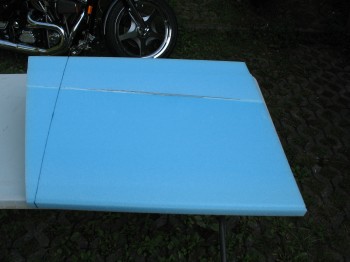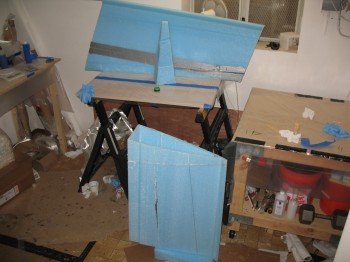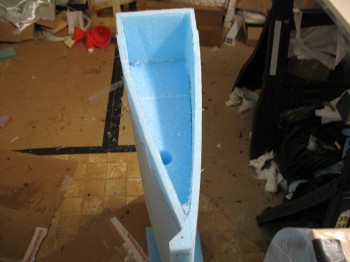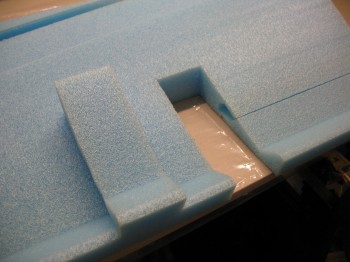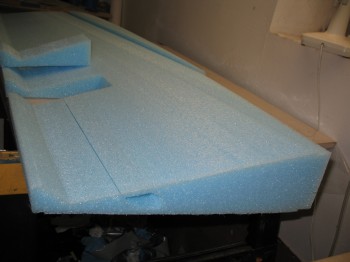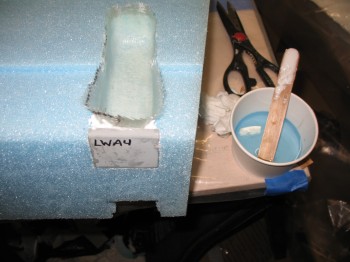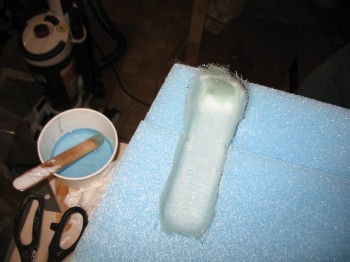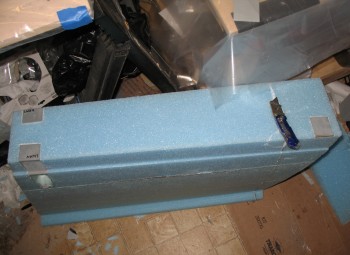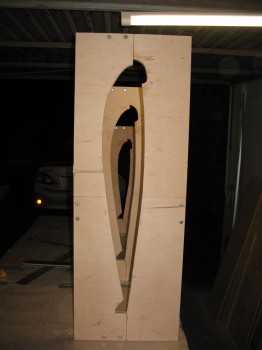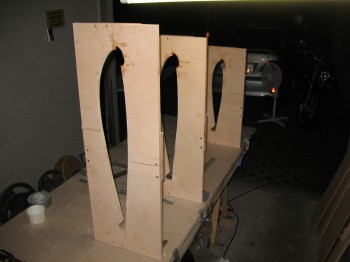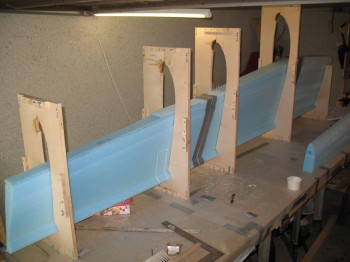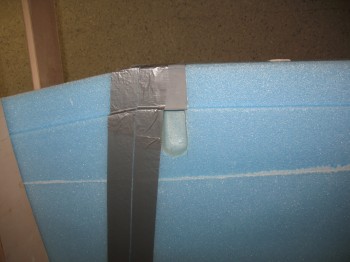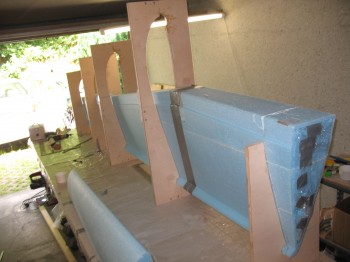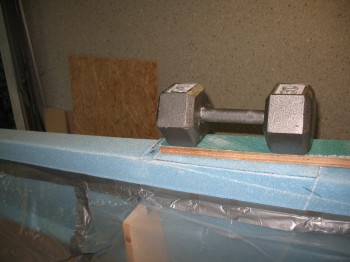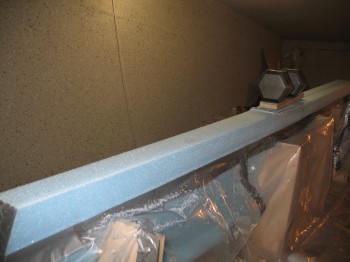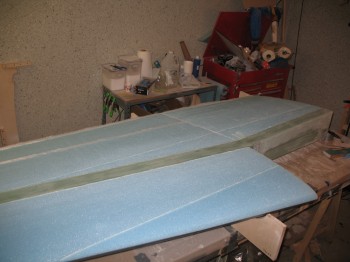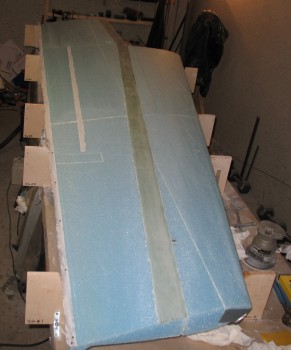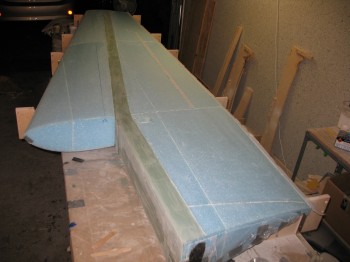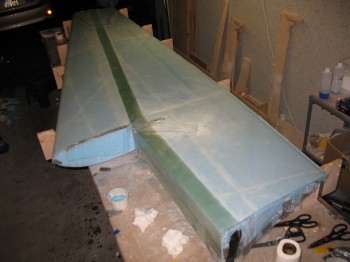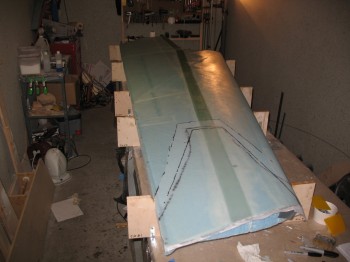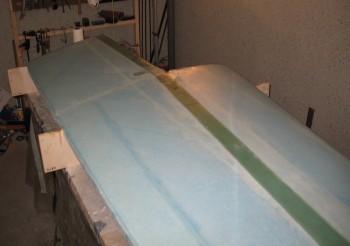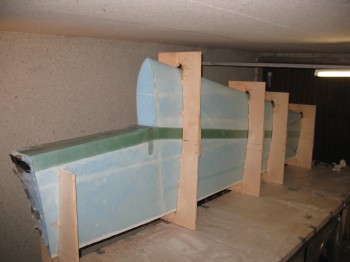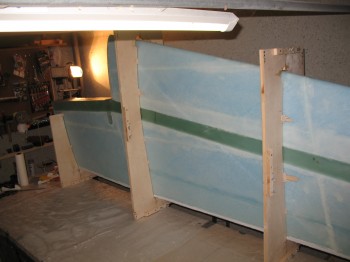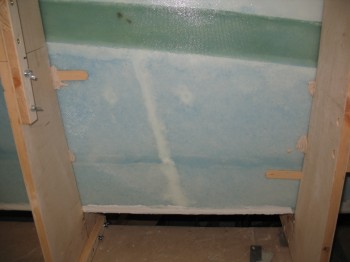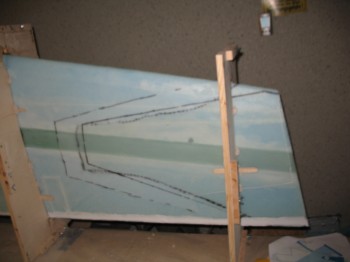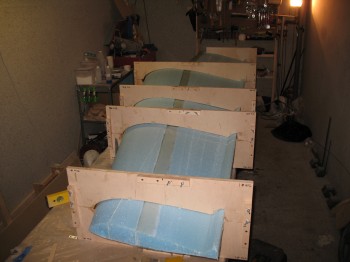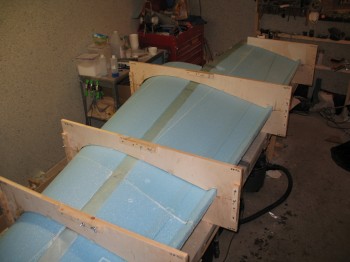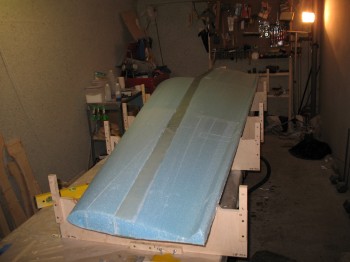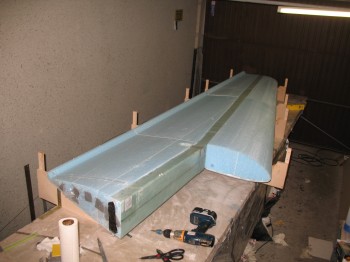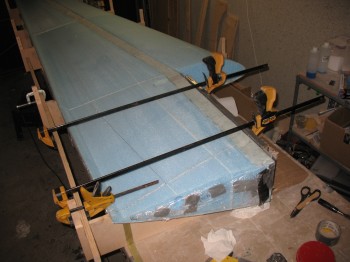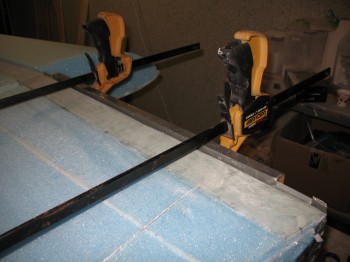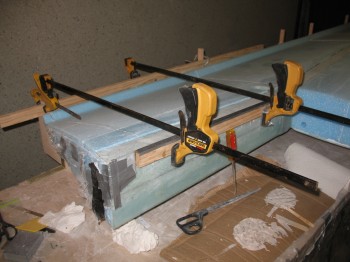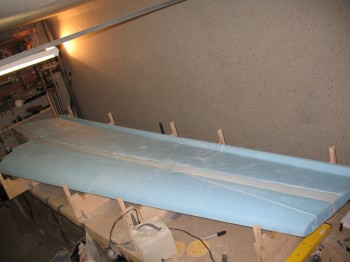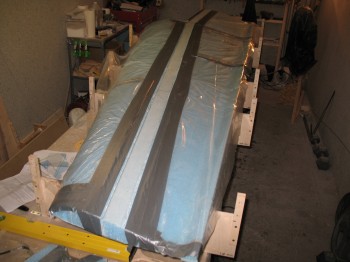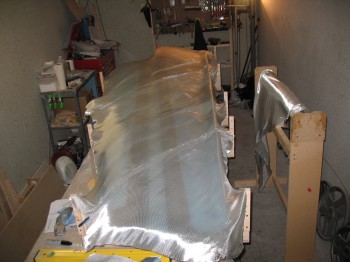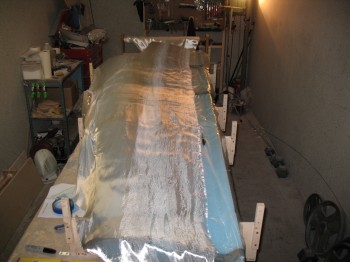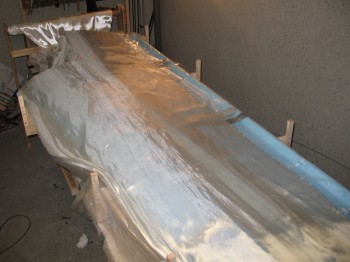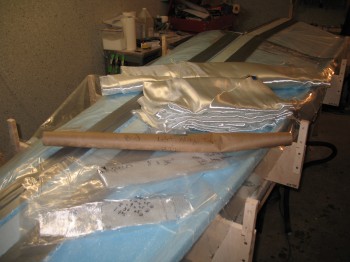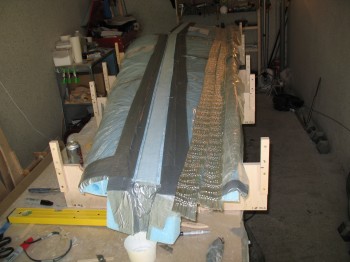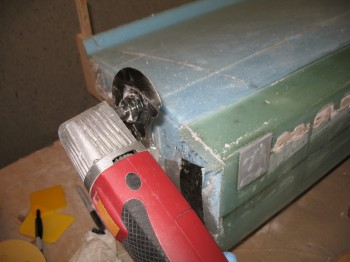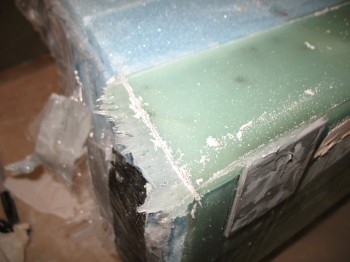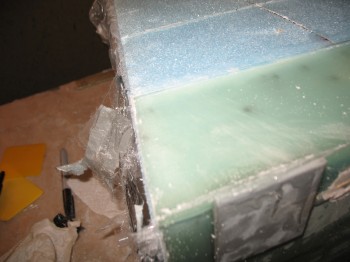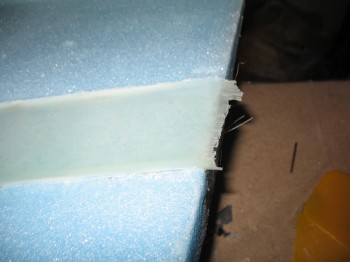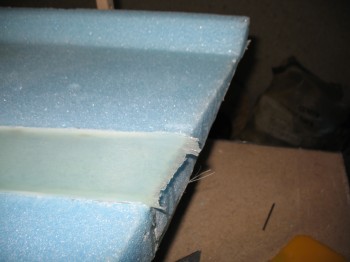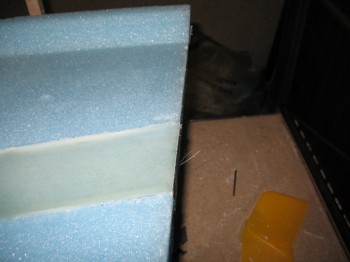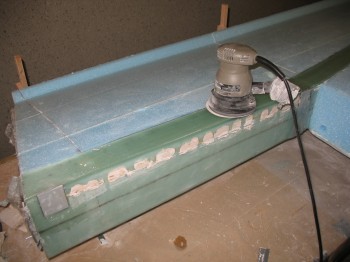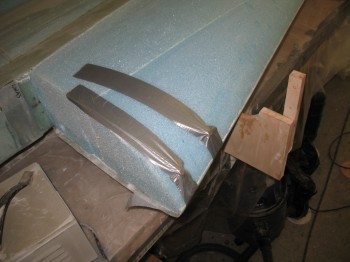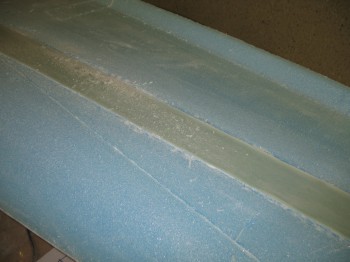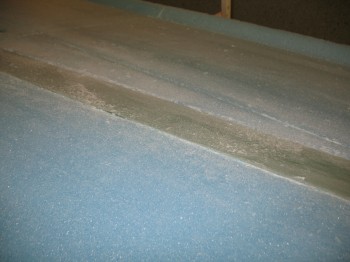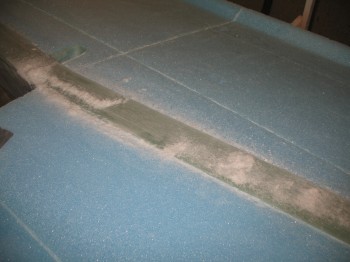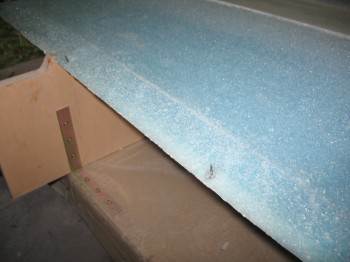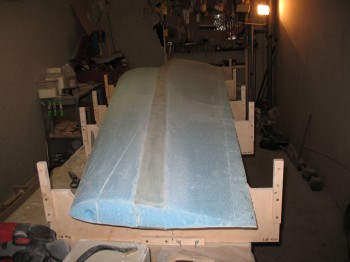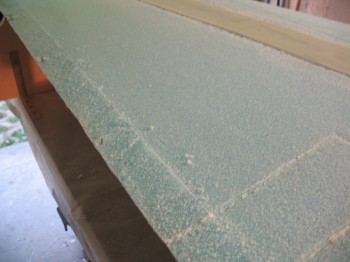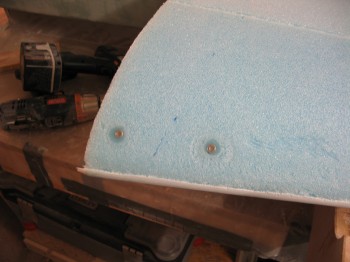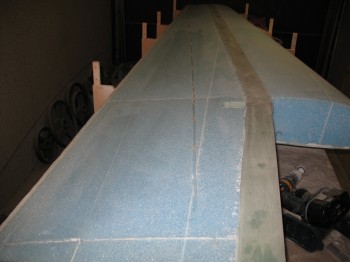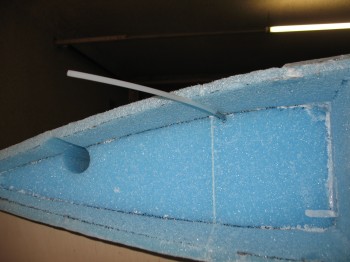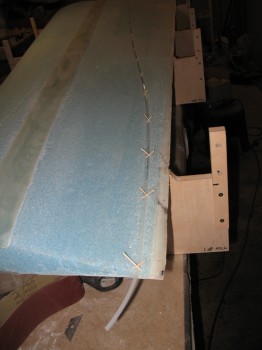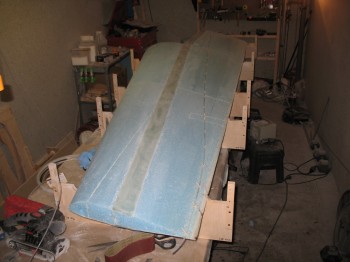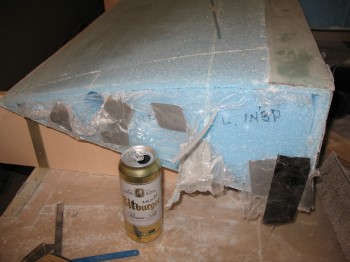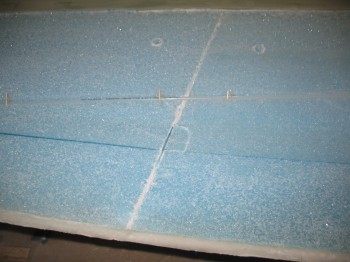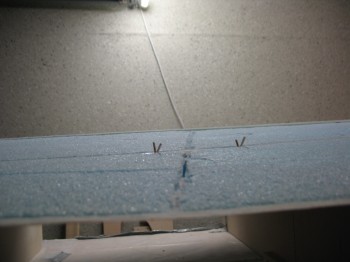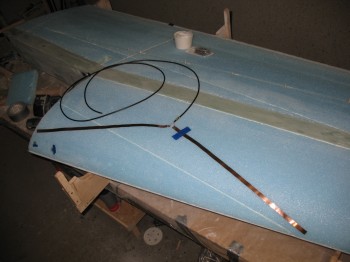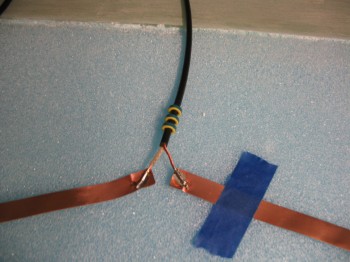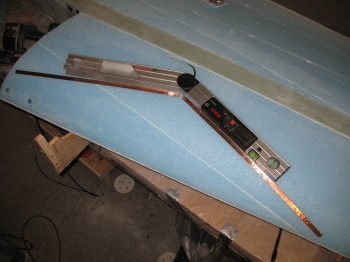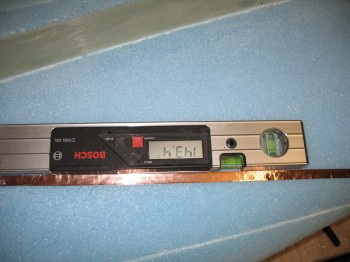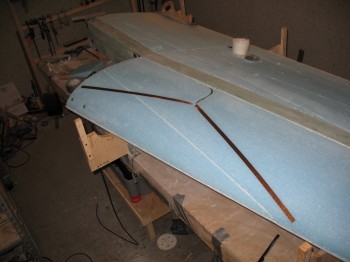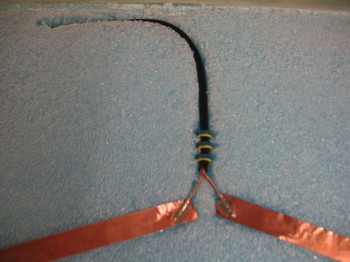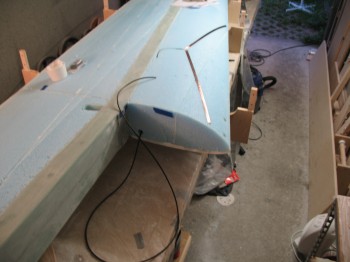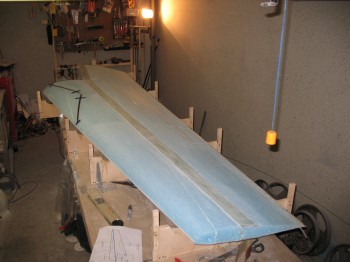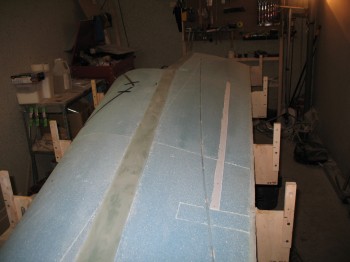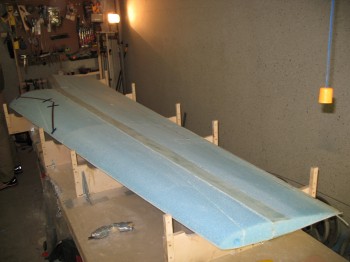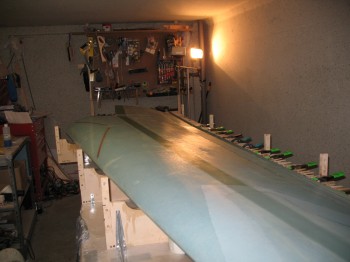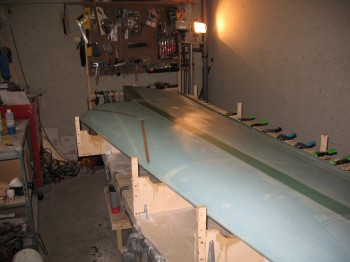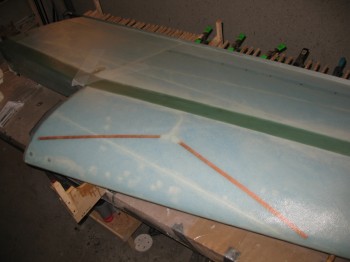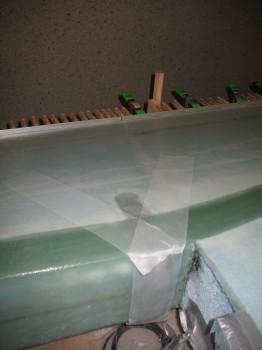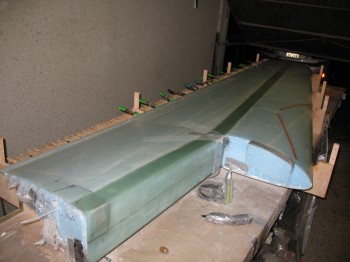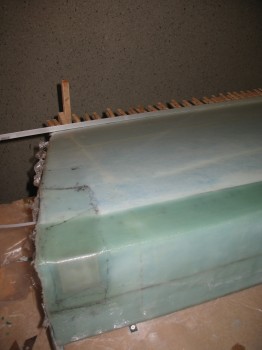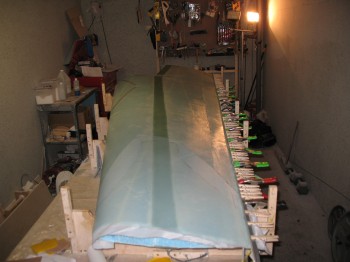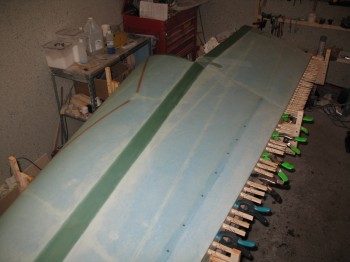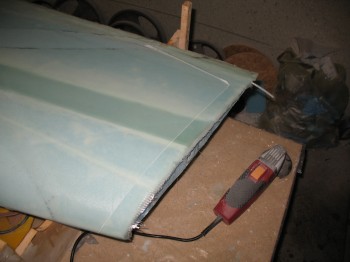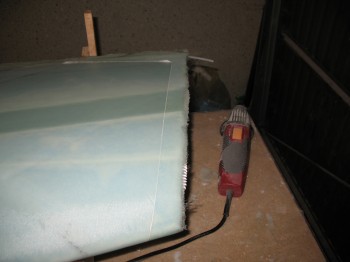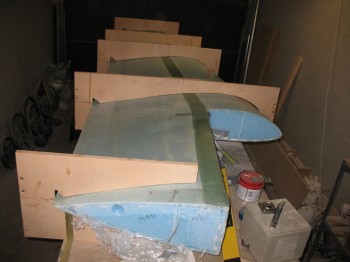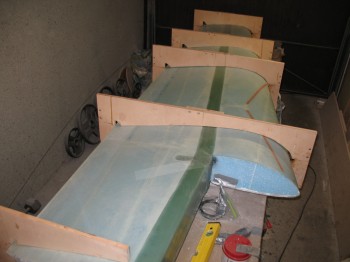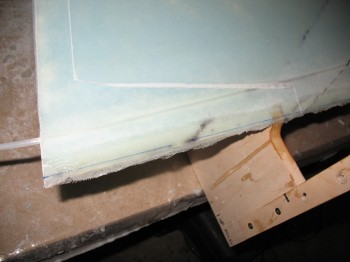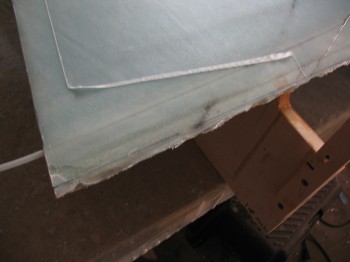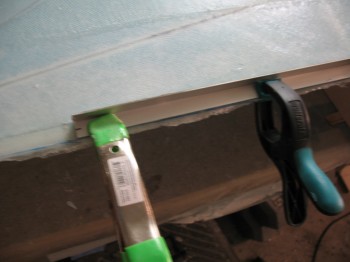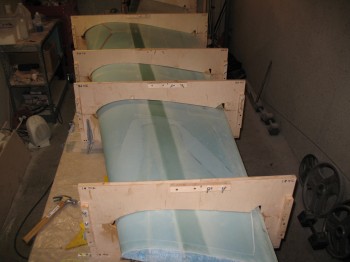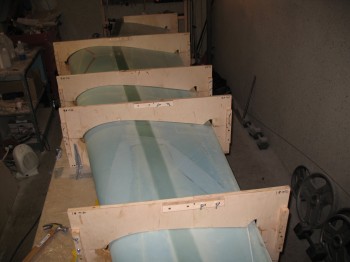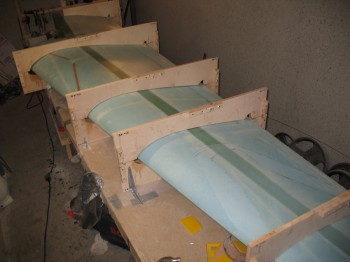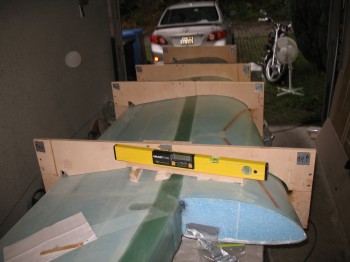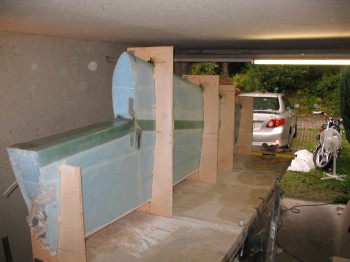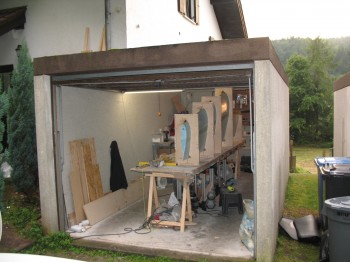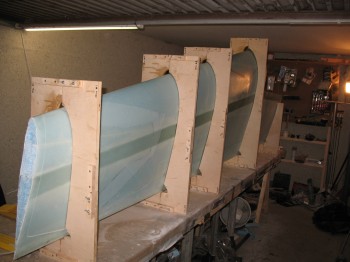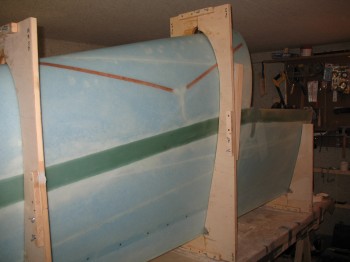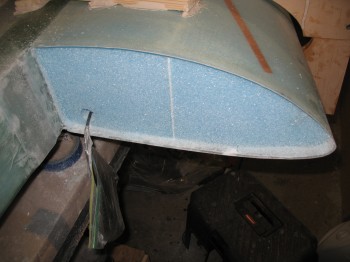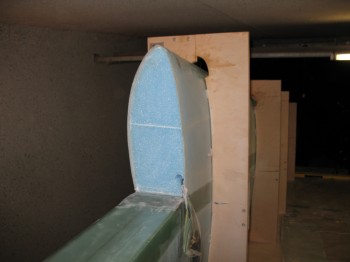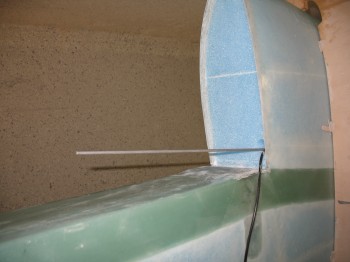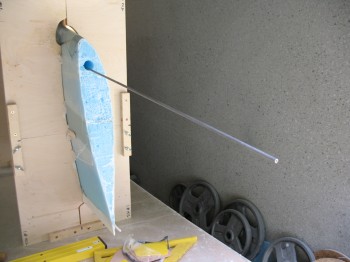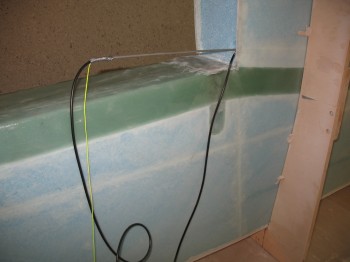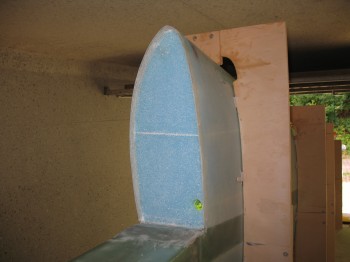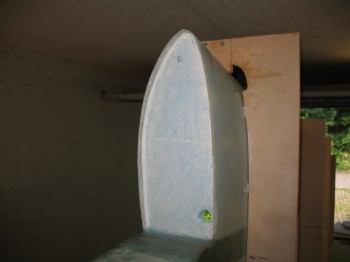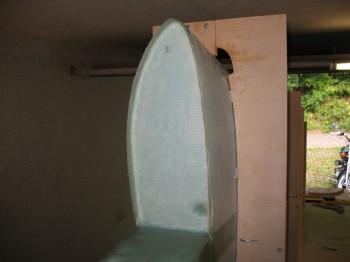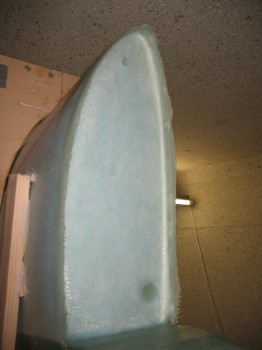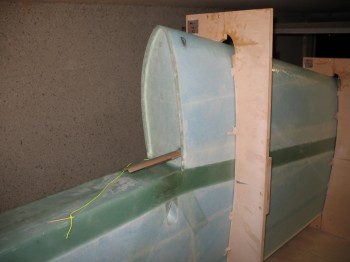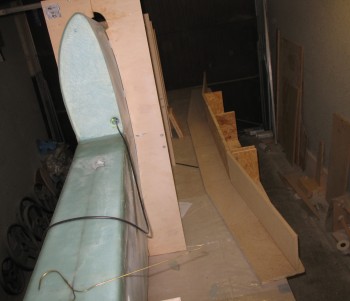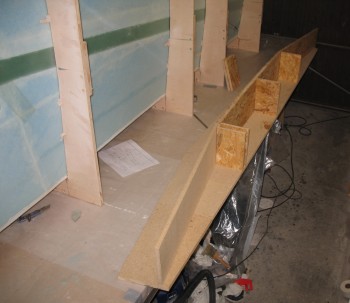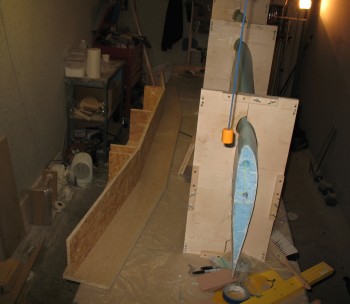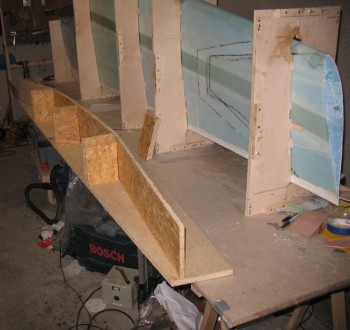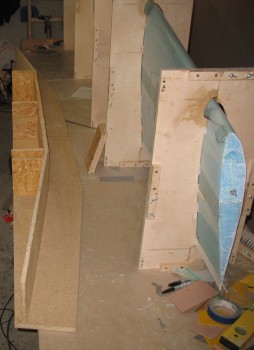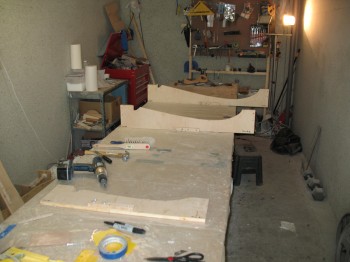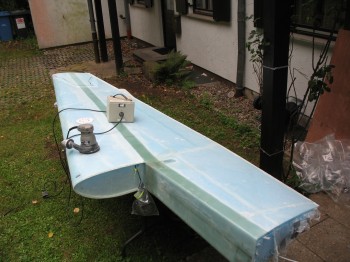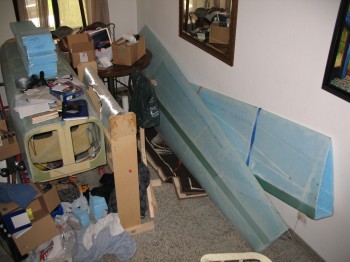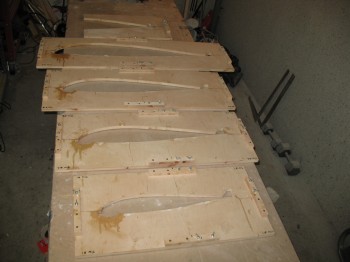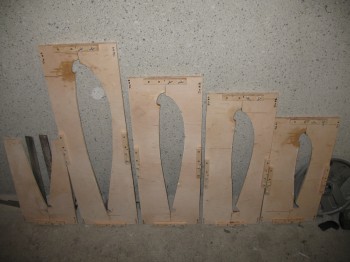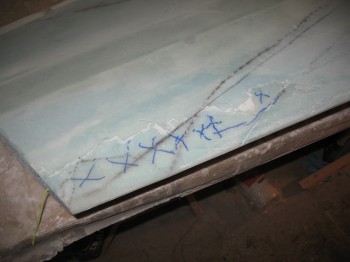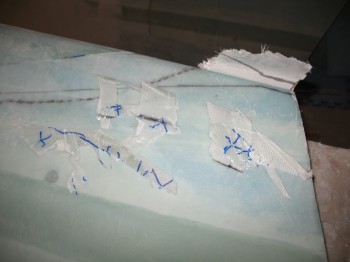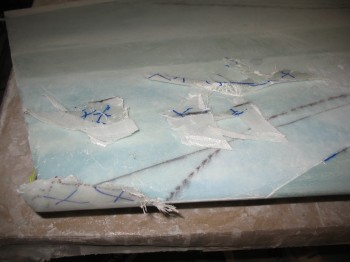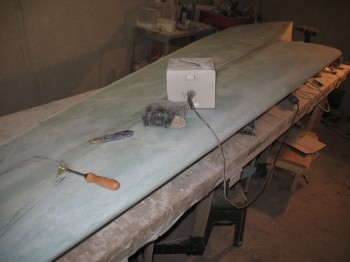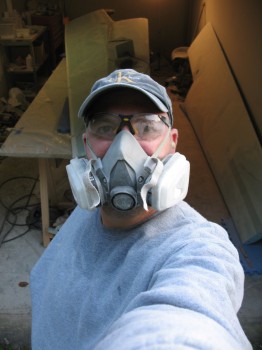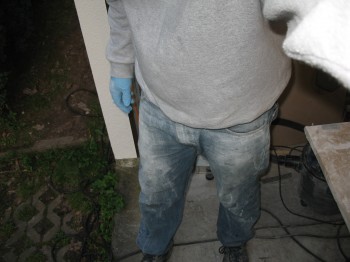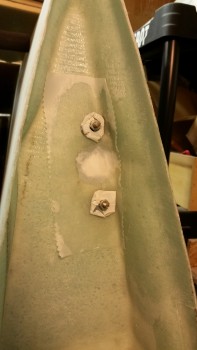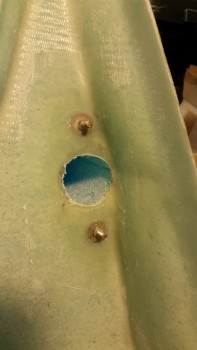Chapter 19 – Left Wing Build
OPERATION GOLIATH – Part II
31 July 2012 — I started out today by removing the protective duct tape & nails used in bonding the pieces together for the LEFT wing’s FC2 section. I also cut the 6″ wedge off the Left wing’s FC1 section for the hollow/inset Inboard end rib.
•••
1 August 2012 — I cut the 6″ wedge from the Inboard side of FC1. Once I cut out the center wedge part, I micro’d the outer shell back to FC1 (Gina was mixing micro and helped a lot with this as well). I then micro’d the two FC2 parts together.
After finishing with the Left wing sections, I refilled the epoxy & hardener bottles, and checked the levels of all my consumables.
•••
3 August 2012 — I micro’d the Left wing FC5 section pieces together, and then the FC4 section pieces together.
•••
7 August 2012 — Gina shaped yet another piece of foam to repair a little spot of damage on the Left wing’s FC1. After micro’ing in & laying up the wing bolt access channels, micro’d the repair piece into FC1.
•••
8 August 2012 — I proceeded to set up the Left wing jigs #1 thru #4. This time, since the work table was now a quasi-permanent fixture, I just mounted the jigs on top of the table.
And again, in keeping with my modus operandi, while inserting the FC2 & FC3 wing sections, I realized that the pieces that make up the Outboard aft section FC3 and the Outboard front section FC5 where bonded together incorrectly. In my haste to multitask, I had micro’d the thin bottom wedge of FC5 to the top of FC3. There was no way around redoing this, since it would completely mess up the Shear Web layup. So I took my wood saw, and very carefully hacked off the incorrect top piece of NC3. I re-micro’d the piece back onto FC5, replete with it’s 0.1″ micro encrusted bottom face (I would deal with that tomorrow). (Pictures to follow)
To end the night on a positive note, I micro’d the pieces of the Left upper winglet together… correctly! (Lucky for me there’s only 2 pieces to it!)
•••
9 August 2012 — Today I very carefully routed & sanded the aft/bottom of FC5 (the Outboard front wing section) to remove the dead epoxy on the surface where it will mate to FC3 (sandwiching the Shear Web), and then made a 0.1″ thick filler piece for FC3.
I micro’d FC2 & FC3, and then set up Jig #5 & micro’d FC1 to FC2. Again, from the Inboard to the Outboard on the aft of the wing are 3 sections: FC1-FC2-FC3.
I prepped the wing assembly for the Shear Web. First off, I micro’d in the inverted L-shaped piece at the junction of FC1’s Inboard 6″ wedge for the inset rib, and the solid portion of FC1.
I micro’d on the 0.1 spacer that covered the entire top of FC3. It was just a tad thick so I could sand it down to nearly the exact thickness required for the entire FC2/FC3 shear web foam to be straight and even.
I then pre-pregged Shear Web UNI (that Gina had precut) like I had on the Right wing & micro’d the spar cap shear web area. I then laid up the shear web.
After the shear web was laid up & set, we micro’d the FC4/5 front wing section to the top of the wing assembly/shear web.
Then the real emergency kicked in!
If you look in the picture just above, you’ll see a weight holding down a micro’d piece of foam. By weighing down the foam, and then sanding the top of the wing assembly (top as it is in the picture) there was apparently too much pressure on the seam of the FC2 and FC3 wing sections. I had checked the micro at that seam & it appeared cured, but I assumed wrong. Moreover, this entire scenario that follows was exacerbated by A) my trying to get the Shear Web layup in & get the build back on track, and B) the plastic skirt taped around the wing assembly just happened to be doubled up right in the FC2-FC3 seam area, so it made for a rather opaque view of the underlying wing foam structure.
It wasn’t until the after the Shear Web UNI layup was glassed, squeegeed and Dritz scissor-trimmed and the FC4/5 front wing section was attached that we pulled the plastic protective skirt off. It was then that I saw what could have been a major & costly setback to this build: The FC2 & FC3 sections had split–apparently from the weight applied during the top surface repair–at the Trailing Edge of the wing by about a 1/4″.
My first reaction was quasi-panic mode … a million options rushed through my head. The first issue was that the micro in between FC2 & FC3 was completely cured, or at least nearly so. The next issue was the effect of just leaving the wing that way, and filling in the gap with micro. I quickly measured the TE edge of the wing. As I suspected, the new gap would make the Left wing significantly longer in span than the Right wing. Plus, although probably slight, the geometry & airflow would be different. In addition, I would have to rework the end of the wing & mess with its angle to install the Winglet, greatly increasing the difficulty of yet another part of the build. I decided the wing had to be put back to the right configuration (this all happened in the span of about 5 min).
I told Gina (who was there to help thank God!) to whip up some semi-dry micro. I then ran around the garage & house to find anything that was long enough and strong enough to go all the way through the meat of the wing to hold it up, one on the FC2 side & one on the FC3 side. I used a long socket extension and a piece of round metal tubing as my wing supports. With those in hand, I grabbed 4 long clamps & reversed the heads to make them spreaders, or in this case jacks. I installed a 1/2″ auger bit in my drill, took a deep breath and drilled a hole all the way through FC2, and then did the same on FC3. I tested my improvised metal supports and they fit great.
Once I had all the parts assembled, I faced the toughest challenge: I had to remove the almost completely cured micro out of the seam between FC2 & FC3. I grabbed my wood saw and slowly worked from the bottom (TE) up. Another downside to this scenario was the location… the TEs (bottom) of FC2 & FC3 were very fragile because the whole TE of FC2 & the FC3 TE section near the seam make up the aileron. Thus, the first 4-6″ of FC2 & FC3 on each side of the seam was literally attached on only one side of the wing by not much foam (I’m not sure, but I would say definitely under 1/2″). With this being the case, as I slowly cut out the micro, 2 small pieces of the thin aileron foam chipped off. After 10 minutes or so, I had the micro out for about 2/3 the way up the wing assembly. The remaining top 1/3 of the FC2-FC3 seam was fairly tight and converging, so I didn’t feel that the micro required removing.
With the bad micro out, it was time to install my improvised wing section lifts. I stuck the socket extension through the wing and used the reverse clamp to put very slight tension on the wing FC2 foam. I then did the same on the other end of the socket extension on the opposite side of the wing, still on the FC2 foam. I then did the same thing on the FC3 section. With my wing section lifts in place, but still with the gap exposed, and even with new tape applied to edge of the foam up to the seam, I applied the new micro into the gap/seam. Once the micro was in place, I slowly applied pressure to all 4 clamps. The gap began to close and we wiped away the excess micro as it squeezed out of the seam. I kept rotating the pressure between all 4 clamps until the gap was completely closed and the seam was tightly closed once again.
We finished cleaning up the seams and stuck a myriad of finish nails into the foam seam edges to keep everything aligned. I then re-squeegeed the Shear Web layup, which thankfully was minimally impacted by this quasi-disaster. I then rechecked the entire rest of the wing, including the front wing section alignment, to ensure nothing else was out of whack. After a few hours I pulled the tape, rechecked the alignment & then used some more micro to lightly set in the broken pieces that had been chipped out with the wood saw. The wing was now whole once again… with no gaps!
Sorry, but I have no pics of the actual repair due to the obvious mass panic that ensued and then working frantically against the clock to repair the wing.
One last thought. It’s amazing how microing one small piece out of place can snowball into a huge crisis. Lesson learned: Be mindful to attention to detail & Be careful in performing the build tasks!
•••
10 August 2012 — Not much to report today. Kind of a slow day build wise.
I pulled the improvised wing section lifts. I then cleaned up the repaired joint between FC2 & FC3, and removed all the nails. Although I had removed a number of nails late last night, the remaining ones were set in the cured micro. Luckily I was able to remove them with minimal damage to the foam.
Overall the repair looked good and the wing was once again at its proper shape & configuration. From the force required to remove the nails, there’s no doubt the micro is completely cured.
I cut the front Inboard wing section wedge off at BL 55.5 just like I did on the Right wing.
I then cleaned up the shop & called it a day.
•••
11 August 2012 — Today I ensured the wing jigs were 90° from the table (sorry, no pics for today). I then floxed the top of the wings to the jigs.
I made 2 foam plugs for the holes I had to drill into the wing at FC2 & FC3. I micro’d in the plugs, cut off the excess foam & cleaned them up.
I Dremelled overhanging glass & dead micro from the spar cap channel. I also Dremelled all the horizontal micro joints/seams.
I removed the L-brackets and laid the wing over bottom side up.
I stringed the wing/jigs level, then shimmed & re-installed the L-brackets to secure the wing.
Another negative aspect of dealing with the split wing issue is that I forgot to peel ply the shear web, thus I will have to sand the shear web on each side (adding a lot of work) before I lay up the spar caps.
I prepped the bottom of the wing so that the shear web/spar cap channel is ready for sanding.
•••
12 August 2012 — I sanded the spar cap with an orbital sander & by hand…then vacuumed. (I apologize, my camera batteries are kaput & keep forgetting to buy new ones… so no pics again)
I Dremelled out the forward side of the spar cap channel to remove dead micro & glass.
I installed the dam for the spar cap layup with bondo, and then taped along each side of the spar cap along the edges & covered the foam with plastic.
I cut the 3″ UNI tape for glassing the spar cap. I marked each piece 1-7.
I then dry-micro’d the edge of the spar cap channels the full length on each side. I found one small bubble/dry spot, so I gave it a quick epoxy injection.
Even the though I sanded the snot out of the shear web/spar cap glass, I added just a dash of flox to the initial epoxy I used for the base spar cap wet-out to add just a little bit more umph to its grip.
I laid up the lower spar cap using the plan’s layup schedule with the added plies as per CP-25. I peel plied the spar cap layup.
After a few hours cure, I removed the protective duct tape & plastic, and rough knife cut each end.
•••
13 August 2012 — Didn’t get a lot done today… and of course forgot those damn batteries!
I removed the peel ply for the Left wing lower spar cap.
I then installed the Left wing tie-down hard point in the plans location for the “thru-the-wing” bolt tie-down, only I used a threaded aluminum baggage pod insert from the Cozy Girrrls… just as I did on the Right wing.
I was exhausted tonight & didn’t want to make any mistakes, so I took the rest of the night off.
•••
14 August 2012 — Today I cut the spar cap ends level with the wing root & wingtip. After buying batteries for the camera – Yeah!!
” . . . and there was much rejoicing!”
I then removed the wood dam for the spar cap layup & sanded the area between BL 23 & BL55.5. I got rid of the bondo and rounded over the corner edge.
I sanded the spar cap & blended it with the contour of the wing. I hand sanded the bottom wing surface with a sanding board to get rid of the ridges and some minor differences in elevation. Especially in the aileron area around the split between the FC2 & FC3 sections.
If you look closely in the pic below (or enlarge it), you can see 2 white dots, one on each side of the micro seam, a little forward of the aileron peel ply strip. Those are the 2 holes I had to drill to put improvised lifting bars through the wing sections to repair the FC2/FC3 split after glassing the shear web and attaching the front wing FC4/5 section.
I vacuumed the entire wing surface, very lightly sanded (and vacuumed again) the Leading Edge (LE) & ran duct tape across the bottom half of the LE. I also tacked on 1″ peel ply on the TE & 65″ across the top of what will be the aileron cutout (wing side).
•••
15 August 2012 — Today I re-sanded the area between the aluminum wing bolt extrusions & the BL 55.5 wing jut out.
Since some of the foam on the Inboard edge of the BL 55.5 jut out was rounded over a bit, I shaped a foam “shelf,” covered it in duct tape and then attached it on the edge of the jut out next to the rounded over edge for the wing glassed skin to lay on and cure at the proper/straight orientation. The tiny bit of a gap created by doing this will be a non-issue since the foam in that area removed down by 0.7″.
I cleaned & vacuumed the work bench.
I put the wing UNI glass in a plastic garbage bags, double bagged (it was drizzling rain off & on) & pre-deployed it to the garage.
I applied thick micro to the deeper joints and used micro-paste on the standard joints. I then used microslurry for the field.
I used slow hardener and laid up the wing glass.
I used 2″ peel ply on the LE & 3″ peel ply on the “V” around the wing bolt access hole.
I lost some of my TE peel ply that was supposed to be under the layup because I had run out of tacks, and tried using staples to keep the peel ply in place. The staples popped right out as soon as a squeegee with some pressure on it passed over the glass above. I’ll just have to deal with that issue when I get to those areas.
I then laid up the BID reinforcement at the end of the wing & peel plied it as well.
I came back a few hours later and knife trimmed both wing ends, BL 55.5 just out & the TE. I also removed the peel ply from the LE & the wing bolt access hole area.
•••
16 August 2012 — Today I started by dry microing the wing TE channel.
I put the jig tops (technically bottoms) back on the wing surface & bondo’d into place. After the bondo cured I flipped the wing front edge up & cleaned the table.
Here below are the two holes I drilled to fix the separated wing sections… now filled, micro’d and glassed. Clearly, the ability to affect repairs is a great advantage to working with foam, glass & epoxy!
I then flipped the wing top side up and spent a bit of time leveling the jigs & wing. After I leveled the wing/jigs, I mounted the jigs to the table with L-brackets.
I sanded the shear web/spar cap with the orbital sander & a hard sanding block. And then vacuumed the entire wing surface.
I then bondo’d the dam in place for the spar cap layup.
•••
17 August 2012 — I removed the clamps from the spar cap layup dam.
I finished hand sanding the sheer web, and then grabbed the Dremel tool and removed the dead micro, epoxy & glass from each side of the spar cap channel.
I re-vacuumed the spar cap & the entire top wing surface.
I duct taped along the edges of the spar cap channel with the ever-ubiquitous protective plastic to protect the wing foam surfaces.
I then shifted gears away from the spar cap prep, to cutting the UNI glass that would be used for the top wing skin AFTER the spar cap is layed up. I pre-cut the UNI cloth before the spar cap layup on the bottom of this wing as well, I just didn’t get any pictures of it. This was somewhat of a departure from how I did the Right wing, with just the roll of UNI on the dispenser. I am now a huge fan of precutting the glass. It makes the layup go much smoother, easier and faster, and it seems to be a little less messy as well.
•••
18 August 2012 — Today I started my last spar cap that I will do on these wings!
I refurbished the epoxy runoffs/downspouts/epoxy recycling assemblies.
I also pre-cut my 3″ UNI tape lengths for laying up in the spar cap trough.
I used a baggy to apply the micro to the edges of the spar cap trough, using the cake-icing method. I then applied epoxy, again with just a dash of flox mixed in, to the shear web surface.
I laid up the spar cap & then peel plied it. I also did a rough knife cut on each end.
After it cured for a few hours I pulled off the protective tape & plastic. By the time I pulled all the tape & plastic off, I was able to rip the peel ply off as well.
I also knocked the dam off.
•••
19 August 2012 — Today I started out by using the “Fein” saw to trim the spar cap glass overhanging the end of the wing at each end.
I then sanded the bondo off the spar cap dam area & rounded the corner just a bit.
After getting the bondo off & the dam area cleaned up, I floxed in the two upper baggage pod threaded inserts on the front of the wing. I taped them in place so that the flox cured nice & flush with the surface of the foam.
I sanded the entire spar cap with the orbital sander, and then used the big gun: a belt sander I had picked up for leveling out the spar caps (it cleans them up nicely… also another Randi tip!). I then vacuumed up all the fiberglass dust.
I used the Dremel tool to remove the dead micro at the seams, junctions and spar cap edges. After cleaning up & vacuuming again, I cut the fishtail from the TE & started removing the 1″ peel ply I had tacked (stapled) onto the TE. I had to use the Dremel on a lot of the TE, because if you remember, a bunch of the peel ply came out after I used staples vs tacks to keep it in place. I did manage to get a fair amount of the peel ply back under the glass while glassing, but not all of it.
I used my straight sanding board to sand the remnants of the fishtail level so the TE was flush & smooth, but I also hit some parts of the wing as well, especially the FC2/FC3 junction SNAFU area. It looked pretty good after hitting it lightly with the sanding block.
•••
20 August 2012 — I’m trying to get the wing prepped for the last major wing layup remaining: skinning the left wing’s upper surface.
Today I spent over 1-1/2 hours removing peel ply from the TE, and still had 18″ left to remove.
I then took the tape off the baggage pod threaded mounts. They came out good.
I routered the Nylaflow rudder cable conduit channel using the Dremel tool. I then installed the Nylaflow & dry micro’d it into place. Of course I held the conduit in place with toothpicks.
In the following pics you can see the damage & repair of the split at the FC2/FC3 seam (during the shear web layup & attaching the nose of the wing).
I fabricated the NAV2 wing VOR antenna & mocked it up.
I wasn’t happy with the Inboard wing bolt aluminum extrusion, so I scuffed it up & re-rounded the edge, and then hit it with some primer since I had some shiny aluminum showing. I’ll scuff up the primered surface & clean it off before glassing.
•••
21 August 2012 — Well, I finally finished removing the peel ply from the TE. I then finished cleaning it up.
I sanded most of the Inboard spar cap area, including around the aluminum wing bolt extrusions. Specifically, there’s a 1″ strip of glass between the Outboard extrusion & the side of the front of wing jut-out (BL 55.5) that was pretty rough & needed some tough love. I sanded it down & got it fairly smoothed out in that 1″ strip. It needs to be smooth since the rib that gets glassed into the front of wing BL 55.5 jut-out will overlap onto this surface. I also cleaned up the aluminum extrusion faces & the wing bolt access overhang piece (W18).
I installed the NAV2 VOR antenna by running the cable into the foam & down into the wing wiring channel.
Again, I formed & taped an extension for the BL 55.5 front of wing jut-out (where the blue tape strip is in the pic above) to be installed and will allow the glass to overhang straight. (both of my Inboard FC4 pieces were rounded over just a bit for about 4″, so I just want to the glass to come straight out and not follow the roundover… which is only about .1-.2″ deep)
I tacked on the 1″ x 65″ peel ply at the aileron junction (again, on the wing side).
The final large UNI layup on the wing is 1 ply of UNI that goes from the Inboard side straight out to the tip of the wing. This starts above the aileron & follows the top edge of the aileron at the aft side of this layup. So, I marked a spot at 5.9″ from the TE at BL 55.5 & put a spot at 4.35″ up from the TE at BL 106.25 to mark the aft UNI edge of this layup. Now, there are a few other smaller layups that get glassed, but this is the last really big one.
•••
22 August 2012 — I started out today by vacuuming the entire top of the wing.
I also refilled my slow hardener bottles & restocked my blue glove supply.
I used a 50:50 slow/fast for the thick micro on the deep fill areas. I used wet flox on the TE & 70:30 micro/flox on the LE. I used 80:20 slow/fast microslurry for the foam fields.
My buddy Kevin helped me by working the epoxy station, and he also helped layup some of the glass as well.
After I got the foam all micro’d, I laid up the wing UNI glass that I had pre-cut.
I peel plied the Outboard extrusion area “V” that borders each side of the wing bolt access hole. I also peel plied the front face of the extrusion (LWA3).
I laid up the 14″, 10″, 6″ plies of UNI over the Inboard extrusion/wing bolt hardpoint & overlapping up onto the wing (just like the Right wing).
I laid up the triangular ply of BID reinforcement on Outboard end of the wing & peel plied it.
I clamped & clothes-pinned an aluminum L-bracket–lined with duct tape–to the TE to keep it as straight as possible as it cures.
I trimmed the excess glass from around the edges & since the weather had turned much cooler, I turned on 2 heaters to keep the shop temp above 70° F.
I came back to check the layup about an hour later. I had a couple of quarter sized bubbles that had developed right at the front edge of the spar cap. I worked those out & re-checked the entire wing layup. Everything looked good!
•••
23 August 2012 — Today I removed the peel ply from the Outboard extrusion/wing bolt access area.
I removed the taped foam shelf from the BL 55.5 wing front jut out.
I then cut the glass straight at the Inboard & Outboard wing ends.
I then grabbed the Right wing from my storage area (yeah, you know…!) & took it out to the yard to measure all the critical dimensions. I measured the length of the LE & the spar cap to BL 55.5 jut out measurement. I also measured the chord at the wing ends.
I cut the top side of BL 55.5 jut out edge.
I then cut the TE at the same distance from the LE as the Right wing.
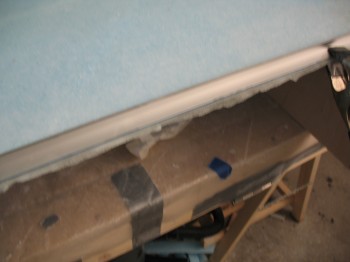
I cleaned up the shop & put the jig tops back on, and then measured the incident angles.
•••
24 August 2012 — Today I bondo’d the wing incident angle board to the top of the wing.
I took the angle brackets off the individual jigs & lifted the wing LE edge up on the table. I then marked & cut the bottom glass of the BL 55.5 jut out.
I then laid the wing down flat again with the wing top up & routered out the BL 55.5 jut out are to 0.7″ deep.
I then stood the wing assembly back up & made some final preps for glassing the BL 55.5 rib tomorrow.
•••
25 August 2012 — Today I finalized the prep for glassing the BL 55.5 wing jut out. I wasn’t happy with the quality of the corners near the wing bolt extrusion area & near that inside at the shear web glass-to-foam junction. So I sanded down those areas… and you could tell I was serious because I broke out the Perma-Grit tools!
After I smoothed out the surfaces to be glassed as best possible, I wanted to get the antenna cable out of the way so I didn’t have to contend with it like I did on the Right wing. I ran a long aluminum tube thru the wing cabling channel, attached some string & the antenna cable to the tube and then pulled it all back far enough inside the channel that I could layup the BL 55.5 rib glass without messing about with the antenna cable.
I cut & laid up 2 each 3″ x 30″ UNI strips over the extrusion & along the edge of the wing bolt access hole in the infamous “V” pattern.
I put a thin layer of flox over the irregular surface just Outboard of the extrusion, between it and the foam. I then filleted the foam/glass corners with dry micro & squeegeed micro- slurry onto foam field.
I pre-pregged the 3-ply BID setup for the BL 55.5 inset rib & laid it up. I overlapped it onto the extrusion area as well.
While the BL 55.5 inset rib was curing, I cut about half of the 1/4″ plywood that I had used for the fuselage bottom “sled” to use for jigs & templates for the next build, Chapter 14 – Center Section (CS) Spar, and a few other chapters as well. I used the 3M 77 spray glue to tack the tracings onto the plywood, and then took the wood to the base wood shop to cut out the jigs & templates.
After returning home, I knife trimmed the 3-ply BID on the edges of the BL 55.5 jut out inset rib.
I mocked up & then cut the wood for the CS spar jig back piece and the front “shelf” pieces. Once I got them cut to size, I mocked it up again to ensure the measurements were correct. (I’m showing the pics here because they show the wing as well)
•••
26 August 2012 — Today I finished the current build of the Left wing. I placed the wing on the table bottom up. I knocked the jigs off the wings & cleaned up the bondo.
I took the wing outside & placed on the fold out work table, and then sanded all the bondo off the wing.
After I finished sanding the bondo off the wing & then cleaned off the wing (the rain helped with that!). I then stored the wing in my environmentally controlled storage facility (ha! yes, my dining room . . .)
Now, let me talk a little bit about some housekeeping items. Literally. Of course in the pic above, it’s a bit messy. Well, since I’m on quite the accelerated schedule–to be able to use all the epoxy I bought en mass–I had to choose between glassin’ & sandin’ versus keeping everything else ship-shape. Essentially, it comes down to my prioritizing the build over pretty much everything else for a few months.
The other item is an issue for the locale in which I am building: trash. Building this airplane, especially since it’s composite, produces A LOT of trash. Unfortunately for a plane builder, Germany is incredibly strict about its trash. Germany has you identify trash into five (5) different categories. Their curbside trash bins are SMALL here and they only pick up each kind of trash about every other week. Thus, I have a lot of build trash that piles up, and not much place to put it. So I get what I can out (often, if the trash isn’t sorted just right, they won’t touch it) and then continue to build. Eventually, all the trash will get out since I will stop building in mid-October for at least 6 months. Luckily, fiberglass & used peel ply doesn’t rot!
Ok, back to airplane building!
I lined up the troops one last time for some photos after their long hard slog. Although not an exact perfect fit, I was very impressed with how well the wing jigs worked. Brilliant idea & brilliant design in my opinion.
•••
6 July 2013 — Today I finally got around to marking something off my long-standing “To-do” list that includes all the nit-noy ancillary tasks that I need to accomplish. So what was this mysterious task?
Well, in my haste to glass the top side of the Left wing, I forgot to pull the big piece of triangular peel ply off the bottom of the wing. This peel ply covers the large triangular 1-ply BID layup that is glassed at the end of the wing as a foundation for multiple plies of glass that will attach to it to structurally hold on the winglet.
On the Right wing I had simply pulled the peel ply back off the leading edge a few inches. Since I forgot on the Left wing, the top skin glass overlapping onto the bottom skin is now actually overlapping onto the bottom skin peel ply. Not exactly structural. Luckily, since the peel ply is a triangular piece, only about 6-8 inches of the very end of the wing’s leading edge is affected. Nothing that can’t be fixed. I just had to mark it and then carefully Dremel away the ineffective overlapping top skin glass & underlying peel ply.
Once I removed the offending glass & peel ply, I continued on in my quest to give the wings a good once over with the sander. The leading edge overlaps with the snarly, prickly glass especially needed sanding down so when we handled the wings nobody would get inadvertently punctured with wayward glass barbs.
Of course sanding fiberglass is never a joy. It’s itchy, messy & not particularly good for the lungs. Of course I was covered head to toe on what proved to be a fairly warm day in Germany. So below is just a couple of pics of the ensuing personal carnage that sanding glass does to one’s own person! Build on!
After I finished sanding the wings & winglets, I vacuumed up the insidiously ubiquitous glass dust that completely covered everything in the garage and got into absolutely everything. Not surprisingly, sanding and vacuuming was my last official build effort for the next upcoming year!
•••
21 October 2015 — Not shown is some work I did on the inboard rib of the right wing to mount two click bonds for the aileron hinge bearing assembly. After floxing the click bonds into place, I laid up 2 plies of BID over the click bonds, added a taped-up washer over each click bond and screwed them down to ensure a flat surface for mounting the aileron hinge bearing. I should have a pic for this soon.
•••
22 October 2015 — And here are the pics I promised of the left wing root rib where I re-attached the two click bonds with flox and then laid up 2-plies of BID over them. These click bonds hold the aileron bearing setup in place. I have one more pic coming showing the mounted aileron bearing.
•••

